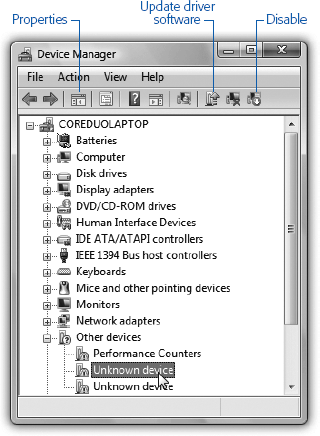The Device Manager
The Device Manager is a technical but extremely powerful tool that lets you troubleshoot and update drivers for gear you’ve already installed. It’s a master list of every component that makes up your PC: floppy drive, CD-ROM drive, keyboard, modem, and so on (Figure 12-4). It’s also a status screen that lets you know which drivers are working properly, and which ones need some attention.

Figure 12-4. The Device Manager lists types of equipment; to see the actual model(s) in each category, you must expand each sublist by clicking the + symbol. A device that’s having problems is easy to spot, thanks to the red Xs and yellow exclamation points.
You can open the Device Manager in any of three ways:
▸ Right-click Computer (in your Start menu or on the desktop); choose Properties from the shortcut menu. In the Systems Properties dialog box, click the Device Manager link at top left.
▸ Choose Start→Control Panel; in Classic view, double-click Device Manager.
▸ Choose Start→Run. In the Run dialog box, type devmgmt.msc and press Enter.
In each of these cases, you’re asked to authenticate yourself (Section 6.3). You then arrive at the screen shown in Figure 12-4.
Red Xs and Yellow !s: Resolving Conflicts
A yellow exclamation point next to the name indicates a problem with the device’s driver. It could mean that either you or Windows installed the wrong driver, or that the device ...
Get Windows Vista Annoyances now with the O’Reilly learning platform.
O’Reilly members experience books, live events, courses curated by job role, and more from O’Reilly and nearly 200 top publishers.

